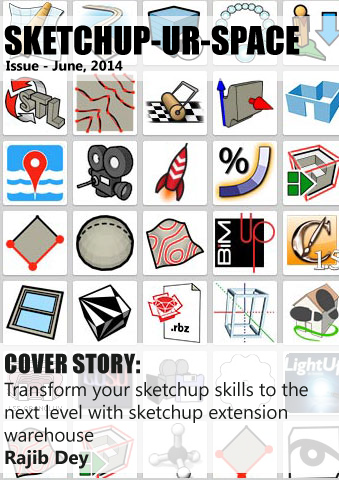|
1. Hello Jim! Welcome to the space of SketchUp. Please tell us something about yourself.
I am an architect living in Denver, Colorado USA and I have always loved hand drawing using technology since I was a five years old when I learned to draw from a television program named “Jon Gnagy Learn to Draw” where we watched the artist sketch on television and copied his drawing technique. Since then I’ve learned to integrate photography and now 3D models in the design visualization process at my planning and landscape design firm studioINSITE. I love teaching drawing to other design professionals and students. I offer several drawing workshops every year in Denver and travel throughout the United States and Canada giving workshops to universities and design firms. My wife Janice is an accomplished collage artist, my son Hunter is an architect in Los Angeles, my daughter Gretchen teaches art at a private school in Seattle and my other daughter Kelsey is a ballet major at Indiana University. I am very honored to have such a creative family and friends!
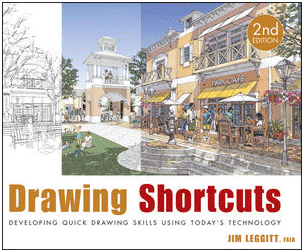
2. How do you find SketchUp?
I learned SketchUp in 2001 when it was first developed. I live just a 30-minute drive from Boulder, Colorado where SketchUp originated. I soon developed close friendships with the key individuals at the company which was named @Last Software and became one of their early promoters of SketchUp. I quickly discovered how to combine 3D SketchUp models with hand drawing and even produced a global webinar series with them about the integration of hand drawing with SketchUp models!
3.You are an architect, urban planner, designer, writer and lecturer. How do you manage all of your avatars at a time?
I am a firm believer that in order to truly be productive, one must develop many different skills and design interests. Instead of being accomplished in only one discipline, I would much rather learn many different design skills and know how to combine them together into new creative directions. A complete designer must have an equal appreciation for urban planning, architecture, landscape architecture, interior design, industrial design and graphic design. Successful designers (and that applies to students as well) must also know how to efficiently manage their time and resources. I have so many different ideas and tasks to accomplish that I daily write down a list in the morning of what needs to be done that day.
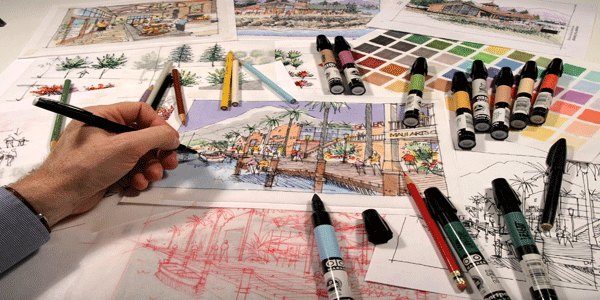
4. How do you utilize SketchUp in your work?
SketchUp has become a valuable design tool in my workplace. I create simple 3D models to use as base images for sketches, I create massing models for urban design projects and occasionally build detailed presentation models for architectural designs. Having integrated SketchUp into my design process this past decade, I sometimes wonder how we designed projects before SketchUp was invented! Now I find it hard to design any project without using some form of a 3D model.
5. From where did you get inspiration of blending SketchUp and hand drawing?
I’ve been merging hand drawings with photographs long before computer models. Prior to using SketchUp, I relied on others to build AutoCAD and Form Z models for me as I did not have those computer skills. When SketchUp arrived in the profession, I quickly taught myself how to model and discovered that I could now build my own models with accurate perspectives and populate scenes with people, trees, furniture, signage and entourage. I also realized that a SketchUp model alone could not convey enough character, color or humanity, and by integrating hand drawing with the computer model view, I could give the scene much more of a “hand crafted” and authentic appearance. Clients responded quite positively to these friendly looking visuals!
6. You are the god father of SketchUp style. How do you manage to create such vast range of style?
I love to experiment with different ways to combine technology with traditional hand drawing techniques. I’m thrilled to see many professional illustrators creating exciting hybrid visualizations that combine SketchUp modeling, digital painting, photography and digital effects. I was once inspired by a friend who made incredible meals by combining different ingredients together while not following any cook book recipe. I’ve carried that attitude of discovery and experimentation into my work by finding new ways to combine different visualization tools and techniques. We are in an exciting “visual evolution” in which designers around the world are discovering new ways to communicate design ideas to clients.
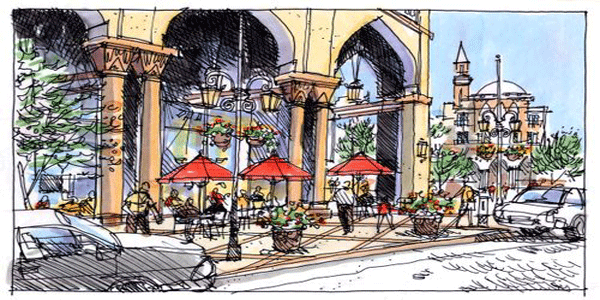
7.Tell us something about your hobby?
Living in Colorado with its beautiful mountains allowed me as a younger person to experience many outdoor activities such as rock climbing, running, river kayaking, hiking, camping, skiing and mountain biking. I admit my middle-age prevents me from participating in many of those extreme sports and therefore now focus on taking long bike rides through the many bike trails around Denver. I recently rode on a 200 mile route from Seattle, Washington to Portland, Oregon with my daughter. Biking is my favorite hobby that keeps me in good shape!
8.You are the writer of “Drawing Shortcuts”. We want to know more about your writing experience of the book and the blog.
Authoring Drawing Shortcuts was a dream come true! I was approached by the John Wiley and Sons editors following a 1999 lecture I gave at an American Institute of Architects convention. They were very interested in the subject of combining traditional hand drawing with technology and asked me to submit a book proposal. It was approved and I spent a year collecting material and writing the book. Following that first edition in 2001 which was published in four languages and adopted by over fifty universities, I was given the opportunity to update the book in 2010. The 2nd edition of Drawing Shortcuts now features SketchUp and many of the hybrid visualization methods I currently teach. My blog enables me to instantly share new ideas and techniques about design communication with everyone around the world. I love featuring other talented visualists and have written close to 200 blog posts and have more than 200,000 page views since I began my blog two years ago! I love hearing stories from others about their visualization methods and am always looking for new ways to communicate design.
9.When will we get your next book?
Glad you asked. I need to take some time off writing books and focus more on my blog and new alternatives for sharing my ideas with a larger global audience. I’ve offered several webinars and a video about design visualization and would really like to offer more online programs that friends around the world can have access to. I’m also curious about developing content for ebooks that can be viewed on an iPad or other digital tablets with constantly updated material.
10.Why do you love to design in SketchUp? What is so special about it?
SketchUp was a “game changer” for my design and visualization process. For the first time in my career, I could construct accurate 3-dimensional models of buildings and planning projects, then integrate those models in my design visualization process. SketchUp is easy for anyone to learn and study design with shadow characteristics, unlimited perspective options and many entourage components downloaded from SketchUp 3D Warehouse. I enjoy using the many plugins for SketchUp that speed up the modeling process. My favorite plugin is the photorealistic software named Shaderlight that applies lighting characteristics and reflections to the SketchUp model scene.
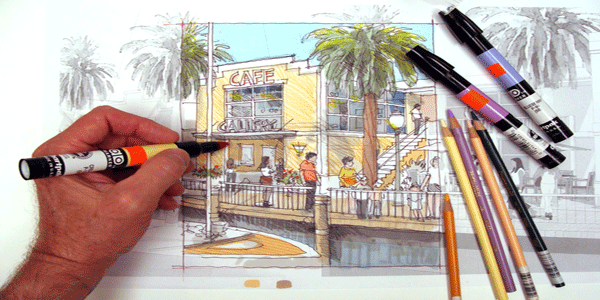
11. In future how do you like to see the development of SketchUp?
Good question. I mostly create simple models and therefore don’t need too many sophisticated modeling tools. I wouldn’t mind taking some SketchUp training from an expert as I’m sure I don’t use half of the tools and features SketchUp offers. I can’t imagine how to make SketchUp any better than it is. The SketchUp software developers are always listening to user concerns and have a successful track record of improving the software with every new release.
12.Tell us something about Leggitt studio?
I recently became a partner with the Denver planning and landscape architectural firm named studioINSITE (www.studio-insite.com) and am beginning to phase out Leggitt Studio due to my new position with the firm. I continue to teach, offer workshops and write about design visualization under the new name of studioINSITE.
13.Please give us some advice to the budding designers and architect.
The design profession is rapidly becoming more demanding in terms of having less time to solve design problems and to produce more work. Clients are asking more from designers and as a result of this “hurry up” design culture, we need to become smarter communicators by making strategic decisions about how we approach and solve design problems, visualize our ideas quickly, and use our time efficiently so as not to take away from other projects or exhaust our fees. I advise young designers to stay current with advancements in technology, embrace traditional visualization techniques and always have a wide range of skills to employ as changes occur in the global economy.
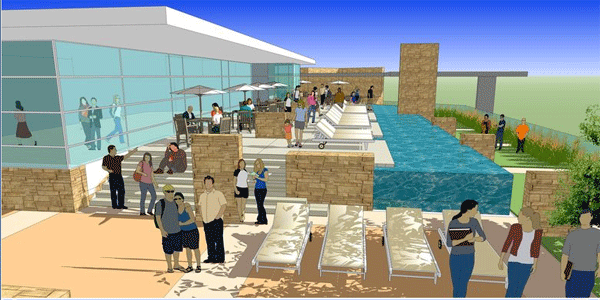
14.What is your opinion about Sketchup ur Space? Please give us some advice.
You are on the right track and I encourage you to continue providing readers with great articles on design visualization and SketchUp modeling. Listen to feedback, follow you heart and especially have fun!
|



